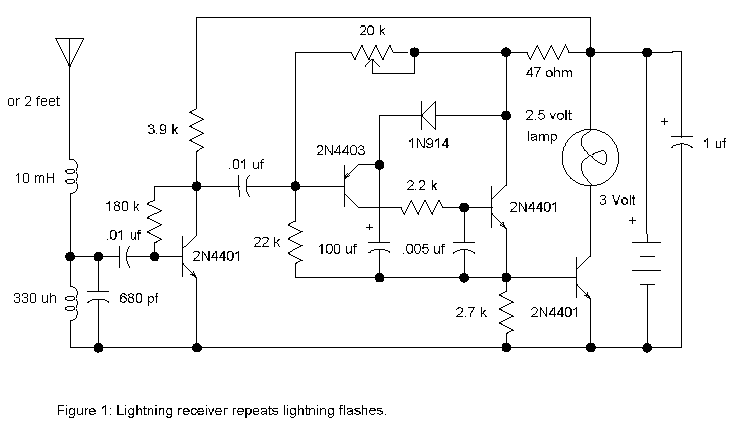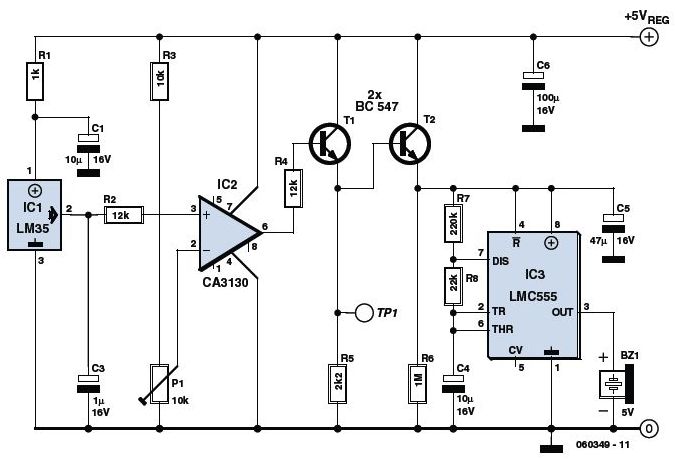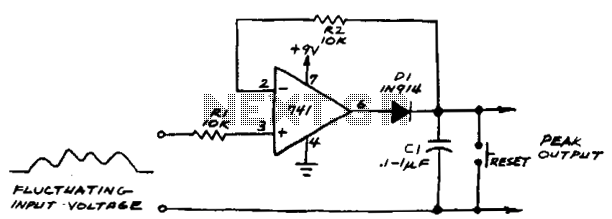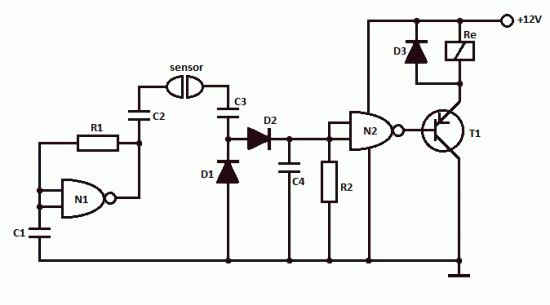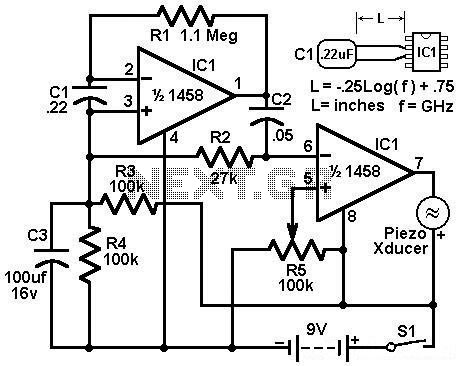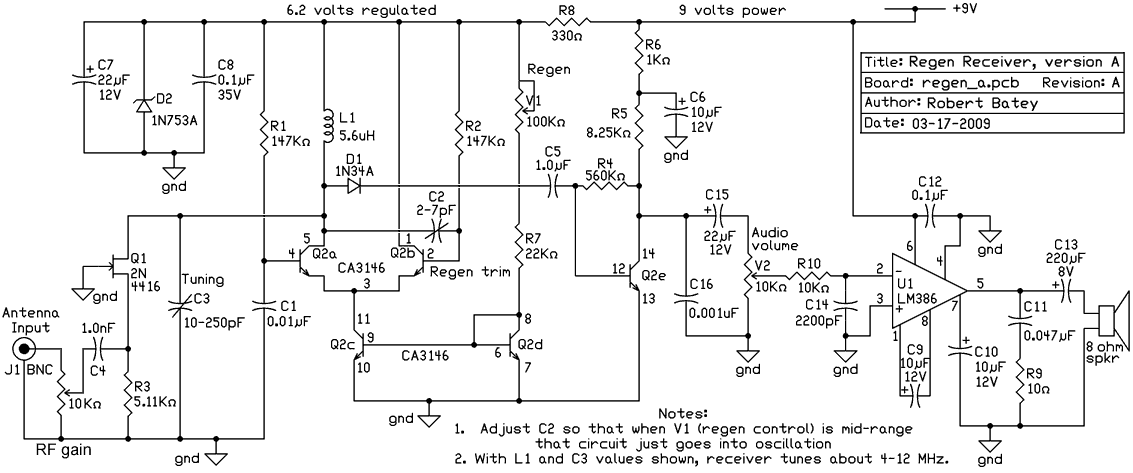
economy radar detector

This circuit utilizes a 1458 dual operational amplifier (op-amp) to create a radar detector. Capacitor C1 serves as the radar signal detector. The first op-amp operates as a current-to-voltage converter, while the second op-amp acts as a buffer to drive a piezo transducer. Resistor R5 establishes the switching threshold for the second op-amp, typically set to trigger just above background noise levels and then slightly adjusted back. The circuit's response can be fine-tuned by modifying the length of the leads connected to C1. For standard road-radar systems, the leads of the input capacitor should measure approximately 0.5 to 0.6 inches in length.
The radar detector circuit based on the 1458 dual op-amp is designed to detect radar signals effectively while minimizing false triggers from background noise. The first op-amp's configuration as a current-to-voltage converter is critical for converting the radar signal's current output into a usable voltage signal. This conversion allows for better signal processing and increases the sensitivity of the radar detection.
The second op-amp's buffering function is essential for isolating the signal from the first op-amp and ensuring that it can drive the piezo transducer without loading the previous stage. This buffering minimizes signal degradation and allows the transducer to produce an audible alert when a radar signal is detected.
Resistor R5 plays a vital role in setting the sensitivity of the circuit. By adjusting R5, the user can set the threshold at which the second op-amp activates, ensuring that the circuit responds only to significant radar signals rather than fluctuating background noise. This adjustment is crucial for maintaining the detector's reliability and effectiveness in various environments.
The tuning of the circuit's response through the length of the leads on capacitor C1 is an interesting aspect of the design. The specified lead length of 0.5 to 0.6 inches is optimized for typical road-radar frequencies, allowing for appropriate capacitance and inductance characteristics that influence the circuit's overall performance. By fine-tuning these leads, users can achieve a more tailored response to specific radar systems, enhancing detection capabilities.
Overall, this circuit exemplifies an efficient design for a radar detector, leveraging the dual op-amp configuration to achieve effective signal processing, sensitivity adjustment, and reliable performance in detecting radar signals.This circuit uses a 1458 dual op-amp to form a radar detector. C1 is the detector of the radar signal. The first op-amp forms a current-to-voltage converter and the second op-amp buffers the output to drive the piezo transducer. R5 sets the switching threshold of the second op-amp; normally it is adjusted so that the circuit barely triggers on bac
kground noise, then it`s backed off a bit. The response of the circuit may be tuned by adjusting the length of the leads on C1. For typical road-radar systems, the input capacitor`s leads should be about 0. 5 to 0. 6 inches long. 🔗 External reference
The radar detector circuit based on the 1458 dual op-amp is designed to detect radar signals effectively while minimizing false triggers from background noise. The first op-amp's configuration as a current-to-voltage converter is critical for converting the radar signal's current output into a usable voltage signal. This conversion allows for better signal processing and increases the sensitivity of the radar detection.
The second op-amp's buffering function is essential for isolating the signal from the first op-amp and ensuring that it can drive the piezo transducer without loading the previous stage. This buffering minimizes signal degradation and allows the transducer to produce an audible alert when a radar signal is detected.
Resistor R5 plays a vital role in setting the sensitivity of the circuit. By adjusting R5, the user can set the threshold at which the second op-amp activates, ensuring that the circuit responds only to significant radar signals rather than fluctuating background noise. This adjustment is crucial for maintaining the detector's reliability and effectiveness in various environments.
The tuning of the circuit's response through the length of the leads on capacitor C1 is an interesting aspect of the design. The specified lead length of 0.5 to 0.6 inches is optimized for typical road-radar frequencies, allowing for appropriate capacitance and inductance characteristics that influence the circuit's overall performance. By fine-tuning these leads, users can achieve a more tailored response to specific radar systems, enhancing detection capabilities.
Overall, this circuit exemplifies an efficient design for a radar detector, leveraging the dual op-amp configuration to achieve effective signal processing, sensitivity adjustment, and reliable performance in detecting radar signals.This circuit uses a 1458 dual op-amp to form a radar detector. C1 is the detector of the radar signal. The first op-amp forms a current-to-voltage converter and the second op-amp buffers the output to drive the piezo transducer. R5 sets the switching threshold of the second op-amp; normally it is adjusted so that the circuit barely triggers on bac
kground noise, then it`s backed off a bit. The response of the circuit may be tuned by adjusting the length of the leads on C1. For typical road-radar systems, the input capacitor`s leads should be about 0. 5 to 0. 6 inches long. 🔗 External reference
